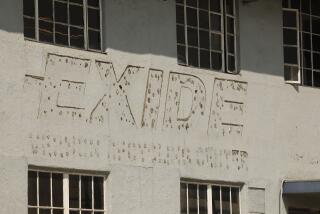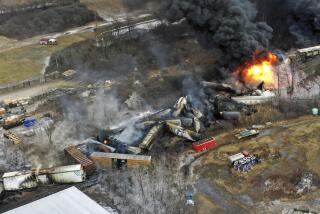Cranes Start Removing Derailed Boxcars : Cleanup: Hot spots of poisonous hydrazine remain. Officials still won’t predict when the freeway will reopen.
- Share via
Huge cranes gingerly lifted crushed boxcars from a Southern Pacific train wreck Thursday as workers tried not to disturb a 5,000-gallon tankful of flammable naphthalene that had lain nearby since the weekend derailment forced closure of the Ventura Freeway in Seacliff.
The cranes were moved to the freeway overpass Thursday morning, just hours after workers in white protective suits finished lifting 53 drums of the poisonous chemical hydrazine from the wreck onto a flatbed truck.
Though the cleanup was progressing steadily after several delays, officials refused to predict when the Ventura Freeway, closed since Sunday, would reopen or when residents would be allowed to return to 49 evacuated houses.
Meanwhile, northbound traffic continued to be rerouted through the Ojai Valley to Santa Barbara, where organizers of an annual cultural festival this weekend fear that it could be disrupted by the closure.
Hot spots of spilled hydrazine remained around the crash site late Thursday, but crane operators wearing only street clothes worked around the tainted areas. They hoped to clear the tracks and replace twisted rails and splintered ties by late Thursday night.
Ventura County firefighters tested the air frequently to make sure that no lingering traces of spilled hydrazine threatened the workers’ health. Eleven workers were overcome by hydrazine vapors Thursday night as the cleanup crew began to remove debris so the large naphthalene tank could be lifted onto a flatbed truck. Nine were taken to a hospital for examination.
“We’re going as rapidly as safety and care will allow,” said Mike Furtney, a Southern Pacific spokesman.
“I think, considering the fact that no one has been seriously injured . . . we’re satisfied” with the progress, Furtney said.
Throughout the afternoon, the cranes swiftly loaded ruptured cargo containers onto waiting trucks, while front-end loaders lifted massive steel train wheels off the tracks.
As Southern Pacific workers pried ruined rails from the wreck with long crowbars, inspectors from the California fire marshal’s office and federal safety agencies surveyed the naphthalene tank.
The oval, silver, double-hulled tank lay sideways near the tracks, along with rolls of multicolored fabric and sacks of sand that had burst from their cargo containers in the crash.
Ventura County Fire Capt. Norman Plott said the tank was not leaking, but could explode if it ruptured and ignited while being moved.
Plott stressed that the freeway and the evacuated Seacliff community cannot be reopened until cleanup workers neutralize the remaining hydrazine hot spots and California Department of Transportation inspectors certify that the overpass is safe.
Four rail cars, piled up against one of the pilings that support two overpasses, still obscured inspectors’ view of possible damage.
Seacliff residents, who were allowed to go home briefly to feed pets and gather belongings, said they were angered by the delay and frustrated because no one would confirm whether the toxic hydrazine fumes could have harmed them.
Hydrazine, used to make products ranging from photographs to pharmaceuticals, irritates the eyes and respiratory tract and causes cancer in laboratory animals.
Authorities issued several conflicting reports on the potential danger of the 440 gallons of hydrazine that spilled from eight ruptured drums and of the 5,000 gallons of liquid naphthalene contained in an unpunctured tank on the same flatbed rail car.
Ventura County fire officials initially said exposure to hydrazine can cause skin irritation, headache and nausea, only later revealing that inhalation or skin absorption can be lethal. And several cleanup officials asserted that the two chemicals react violently if mixed. In fact, chemical experts say, the two are compatible and mixing them poses no fire hazard.
Seacliff resident Tim Carroll, 33, said he is most upset by the risk that the spilled hydrazine might have posed to him and his 4-year-old son, Adam. Both were home at the time of the thunderous crash Sunday afternoon.
Carroll, wearing ill-fitting clothes that he borrowed from a friend after the hurried evacuation, said he is also “really frustrated with having to drag my kid around and staying with friends.”
The musician and part-time carpenter said he missed two gigs and a carpentry job because he could not get to equipment stored in his garage.
“Those clouds came up and kept coming down,” he said. “Who’s to say it’s not in the sand, the trees, or that when it rains it won’t get into the soil where my son plays? Who’s to say it’s safe?”
The train wreckage was scattered less than 50 yards from the front doorstep of Michael Cord, who went home briefly Thursday to feed his cats.
Cord, 41, said he stepped out of the shower just as his wife, Marianne, saw the accident through the kitchen window.
“The whole house shook. It was deafening,” he said. “The trains go by here about five times a day and we’re used to the noise, but this one really went for it.”
Wayne and Mary Engle, both 53, were at Sunday Mass when the accident occurred and were unable to go back home at all for two days.
“I think my concern now is . . . that the community is unaware of what these trains are carrying,” said Wayne Engle as he returned to pick up fresh clothes.
But Southern Pacific’s Furtney said, “We must move these materials. They’re an integral part of everybody’s life. They’re a fact of life.”
Southern Pacific officials are reviewing their safety procedures and may change some of them because of the Seacliff derailment, Furtney added.
A Sheriff’s Department spokeswoman said evacuated residents should contact the department’s dispatch center at 654-5000 to leave phone numbers where they can be reached when officials reopen the community.
Rail Accidents by the Numbers Despite rail accidents in California and South Carolina this week, government and railroad industry officials say derailments have declined over the last decade : THE GOVERNMENT:
“Rail safety has improved dramatically in the past dozen years--a decrease of 74% in train accidents and a decrease of 68% in the accident rate.” --Transportation Secretary Samuel K. Skinner THE INDUSTRY NUMBERS:
The Assn. of American Railroads said that with the exception of an occasional blip, annual accidents have decreased steadily.
Year Derailments Derailments Per Million Miles 1980 6,442 9.88 1990 2,140 3.52
THE ACCIDENTS:
Under government rules, derailments causing more than $5,700 in damage must be reported as accidents. The railroad association said that more than 40% of accidents involve single freight cars moving in freight yards.
SOURCE: Associated Press
More to Read
Sign up for Essential California
The most important California stories and recommendations in your inbox every morning.
You may occasionally receive promotional content from the Los Angeles Times.










